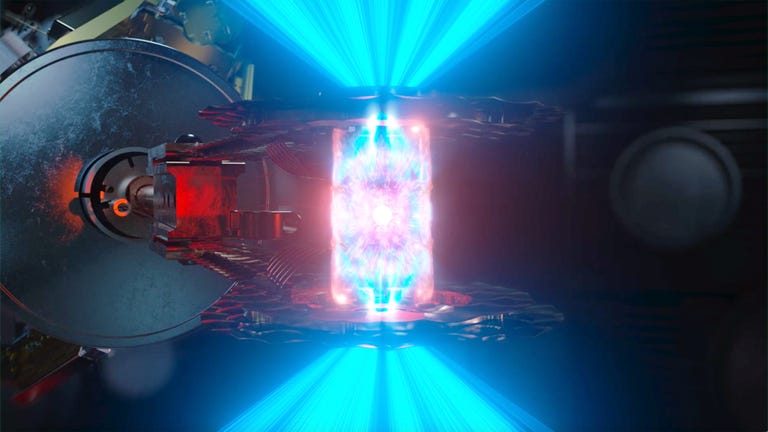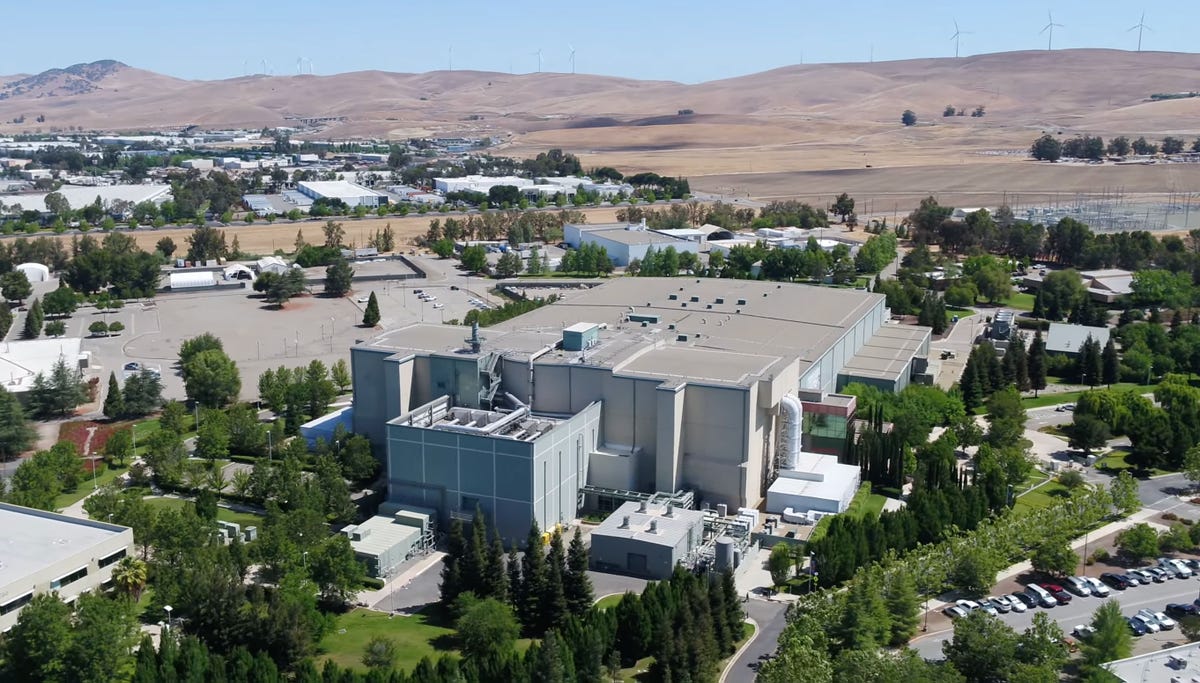Scientists at Lawrence Livermore National Laboratory who achieved a major fusion milestone a year ago have repeated it three times more. Each experiment used 192 lasers to ignite a fusion reaction that for a fleeting moment produced more energy than was used to trigger it.
Fusion powers the sun, and humans reproduced the process more than 70 years ago to power thermonuclear weapons. The scientific and engineering challenges of a controlled fusion reaction, though, are formidable. The repeated successes by the scientists at LLNL’s National Ignition Facility, gradually increasing the laser power that causes a tiny fusion fuel pellet to implode, are important steps of progress toward sustained, controlled fusion.
“Higher laser energy can help achieve a more stable implosion, resulting in higher yields,” said Jean-Michel Di Nicola, a NIF leader, in a statement after the fourth fusion success on Oct. 30.
But what do the experiments mean for science and for the dream of a new energy source that would power our homes and cars without releasing any carbon dioxide?
In short, it’s fine to applaud the NIF achievements, but they don’t mean a green energy revolution is imminent. It’ll still be years before fusion power progress bears fruit — likely a decade or so — and it’s still not clear if fusion will ever be cheap enough to radically transform our power grid. Continuing today’s investments in solar and wind is critical to combating climate change.

Watch this: How This Lab Produced a Historic Nuclear Fusion Reaction
06:37
Commercial fusion ventures applauded the NIF experiment and have made gradual progress since then. Commonwealth Fusion Systems opened a new headquarters in Devens, Massachusetts, where it’s building an experimental reactor designed to produce power. Tokamak Energy and General Fusion announced new facilities to be built near Oxford in the UK. Microsoft has agreed to buy fusion power from a Helion Energy plant called Constellation scheduled to go online in 2028. Other startups like Zap Energy and TAE Technologies are touting progress, too.
Here’s a look at what’s happened and what’s still to come.
What is fusion?

The National Ignition Facility at Lawrence Livermore National Laboratory is the size of three football fields.
Nuclei? Hydrogen? Catch me up on atomic physics, please
Sure! Here’s a quick refresher.
Everything on Earth is made of tiny atoms, each consisting of a central nucleus and a cloud of negatively charged electrons. The nucleus is made of neutrons and positively charged protons. The more protons in the nucleus, the heavier the element is.
Hydrogen usually has one proton and one electron. An unusual variety called deuterium has a neutron, too, and using nuclear reactors or fusion reactors, you can make a third variety called tritium with two neutrons.
Chemical reactions, like iron rusting or wood burning, occur when those positive and electrical charges cause atoms to interact. In comparison, nuclear reactions occur when the nuclei of atoms split apart or join together. Here on Earth, it’s harder to marshal the required forces to get nuclear reactions to take place, which is why it’s easier to make a steam engine than a nuclear bomb.
When you heat atoms up enough, they get so energetic that the electrons are stripped loose. The resulting cloud of negatively charged electrons and positively charged nuclei is called a plasma, a more exotic state of matter than the solids, liquids and gases that we’re used to at room temperature here on Earth.
The sun is made of plasma, and fusion reactors need it, too, to get those hydrogen nuclei to bounce around energetically enough. A convenient property of plasmas is that their electrically charged particles can be manipulated with magnetic fields. That’s crucial to many fusion reactor designs.
What do you use for fusion fuel?
NIF and most other fusion projects use the two heavy versions of hydrogen, deuterium and tritium, called DT fuel. But there are other options, including hydrogen-boron and deuterium-helium-3, a form of helium with only one neutron instead of the more common two.
To get deuterium and tritium to fuse, you need to heat a plasma up to a whopping temperature of about 100 million degrees Celsius (180 million degrees Fahrenheit). Other reactions are even higher, for example about a billion degrees for hydrogen-boron fusion.
Deuterium can be filtered out of ordinary water, but tritium, which decays away radioactively over a few years, is harder to come by. It can be manufactured in nuclear reactors and, in principle, in future fusion reactors, too. Managing tritium is complex, though, because it’s used to boost nuclear weapon explosions and thus is carefully controlled.
How do you turn that fusion reaction into power?
The deuterium-tritium fusion reaction produces fast-moving solo neutrons. Their kinetic energy can be captured in a “blanket” of liquid that surrounds the fusion reactor chamber and heats up as the neutrons collide.
That heat is then transferred to water that boils and powers conventional steam turbines. That technology is well understood, but nobody has yet connected it to a fusion reactor. Indeed the first generation of fusion power reactors being built today are designed to exceed Q=1, but not to capture power. That’ll wait for the pilot plants that are expected to arrive in the next wave of development.
Is fusion work funded by the government or the private sector?
Both. NIF is funded by the US government’s nuclear weapons program. Government funding also pays for the Joint European Torus in the UK and ITER in France, both of which are more closely aligned with the goal of fusion energy generation.
But increasingly fusion energy is privately funded. Investors have poured $4.8 billion total into fusion energy startups, of which $2.8 billion arrived in the last year, according to the Fusion Industry Association’s annual report published earlier in 2022. Most of that went to Commonwealth Fusion Systems, a startup that spun out of MIT and raised more than $1.8 billion in a funding round in 2021.
The government is now helping the private sector, too. The US Energy Department in September 2022 announced a Milestone Program that provides up to $50 million to build fusion energy pilot plants. The Biden administration, a fusion proponent, said in November 2022 that fusion energy is one of five key approaches to halve carbon emissions by 2030 and reach net zero emissions by 2050.
“Uncle Sam is getting serious,” said Holland of the Fusion Industry Association. NIF’s achievement is “a pass-the-torch moment, where it goes from science and national labs to the commercial sector.”
How is fusion different from fission?
Fission, which powers today’s nuclear reactors, is the opposite of fusion. In fission, heavy elements like uranium split apart into lighter elements, releasing energy in the process.
Humans have been able to achieve fusion for decades with thermonuclear weapons. These designs slam material like uranium or plutonium together to trigger a fission explosion, and that provides the tremendous energy needed to initiate the secondary and more powerful fusion reaction.
In bombs, the process occurs in a fraction of a second, but for energy production, fusion must be controlled and sustained.
Do fusion reactors create radioactive waste?
Yes, generally, but it’s not nearly as troublesome as with fission reactors. For one thing, most of the radioactive emissions are short-lived alpha particles — helium nuclei with a pair of protons and a pair of neutrons — that are easily blocked. The fast-moving neutrons can collide with other materials and create other radioactive materials.
Fusion reactors’ neutron output generally will degrade components, requiring periodic replacement that could require downtime lasting perhaps a few months every few years. It’s vastly easier to handle than the high-level nuclear waste of fission power plants, though.
Hydrogen-boron fusion is harder to achieve than deuterium-tritium fusion, but part of its appeal is that it doesn’t produce any neutrons and attendant radioactive materials. The most prominent company pursuing this approach is TAE Technologies.
What are the safety risks of fusion power?
Fusion power plants don’t have the meltdown risks that have caused problems with fission reactors like the Fukushima and Chernobyl sites. When a fusion reaction goes awry, it just fizzles out.
But there still are significant operational issues that you’ll see at major industrial sites, including a lot of electrical power and high-pressure steam. In other words, the big problems are more like those you’d find at an industrial site than at one of today’s fission nuclear power plants.
So there are real advantages to fusion. NIF’s work helps show that there’s a future for fusion energy. But there’s still a very long way to go.


